Solution-Processed Smooth Copper Thiocyanate Layer with Improved Hole Injection Ability for the Fabrication of Quantum Dot Light-Emitting Diodes
Abstract
:1. Introduction
2. Materials and Methods
2.1. Materials
2.2. Device Fabrication
2.3. Characterization Methods
3. Results and Discussion
3.1. Characterization of CuSCN Layers and CdSe QDs
3.2. Device Evaluation
4. Conclusions
Supplementary Materials
Author Contributions
Funding
Institutional Review Board Statement
Informed Consent Statement
Data Availability Statement
Conflicts of Interest
References
- Colvin, V.L.; Schlamp, M.C.; Allvisatos, A.P. Light-emitting diodes made from cadmium selenide nanocrystals and a semiconducting polymer. Nature 1994, 370, 354–357. [Google Scholar] [CrossRef]
- Park, M.; Roh, J.; Lim, J.; Lee, H.; Lee, D. Double Metal Oxide Electron Transport Layers for Colloidal Quantum Dot Light-Emitting Diodes. Nanomaterials 2020, 10, 726. [Google Scholar] [CrossRef] [Green Version]
- Sun, Y.; Su, Q.; Zhang, H.; Wang, F.; Zhang, S.; Chen, S. Investigation on Thermally Induced Efficiency Roll-Off: Toward Efficient and Ultrabright Quantum-Dot Light-Emitting Diodes. ACS Nano 2019, 13, 11433–11442. [Google Scholar] [CrossRef] [PubMed]
- Xu, J.; Wang, L.; Zhao, X.; Shi, Y.; Shi, Y.; Liu, T. High-Performance Blue Quantum Dot Light Emitting Diode via Solvent Optimization Strategy for ZnO Nanoparticles. Nanomaterials 2021, 11, 959. [Google Scholar] [CrossRef]
- Cao, F.; Wu, Q.; Yang, X. Efficient and Stable Inverted Quantum Dot Light-Emitting Diodes Enabled by An Inorganic Copper-Doped Tungsten Phosphate Hole-Injection Layer. ACS Appl. Mater. Interfaces 2019, 11, 40267–40273. [Google Scholar] [CrossRef] [PubMed]
- Kwak, J.; Bae, W.K.; Lee, D.; Park, I.; Lim, J.; Park, M.; Cho, H.; Woo, H.; Yoon, D.Y.; Char, K.; et al. Bright and Efficient Full-Color Colloidal Quantum Dot Light-Emitting Diodes Using an Inverted Device Structure. Nano Lett. 2012, 12, 2362–2366. [Google Scholar] [CrossRef] [PubMed]
- Shen, H.; Gao, Q.; Zhang, Y.; Lin, Y.; Lin, Q.; Li, Z.; Chen, L.; Zeng, Z.; Li, X.; Jia, Y.; et al. Visible quantum dot light-emitting diodes with simultaneous high brightness and efficiency. Nat. Photonics 2019, 13, 192–197. [Google Scholar] [CrossRef]
- Chrzanowski, M.; Zatryb, G.; Sitarek, P.; Podhorodecki, A. Effect of Air Exposure of ZnMgO Nanoparticle Electron Transport Layer on Efficiency of Quantum-Dot Light-Emitting Diodes. ACS Appl. Mater. Interfaces 2021, 13, 20305–20312. [Google Scholar] [CrossRef]
- Wu, J.; Chen, L.; Tan, X.; Zhang, Q.; Xiong, Z.; Lei, Y. Large Performance Enhancement in All-Solution-Processed, Full-Color, Inverted Quantum-Dot Light-Emitting Diodes Using Graphene Oxide Doped Hole Injection Layer. J. Phys. Chem. C 2020, 124, 11617–11624. [Google Scholar] [CrossRef]
- Zhang, H.; Sun, X.; Chen, S. Over 100 cd A−1 Efficient Quantum Dot Light-Emitting Diodes with Inverted Tandem Structure. Adv. Funct. Mater. 2017, 27, 1700610. [Google Scholar] [CrossRef]
- Wang, S.; Guo, Y.; Feng, D.; Chen, L.; Fang, Y.; Shen, H.; Du, Z. Bandgap tunable Zn1–xMgxO thin films as electron transport layers for high performance quantum dot light-emitting diodes. J. Mater. Chem. C 2017, 5, 4724–4730. [Google Scholar] [CrossRef]
- Mashford, B.S.; Stevenson, M.; Popovic, Z.; Hamilton, C.; Zhou, Z.; Breen, C.; Steckel, J.; Bulovic, V.; Bawendi, M.; Coe-Sullivan, S.; et al. High-efficiency quantum-dot light-emitting devices with enhanced charge injection. Nat. Photonics 2013, 7, 407–412. [Google Scholar] [CrossRef]
- Zheng, D.; Wang, G.; Huang, W.; Wang, B.; Ke, W.; Logsdon, J.L.; Wang, H.; Wang, Z.; Zhu, W.; Yu, J.; et al. Combustion Synthesized Zinc Oxide Electron-Transport Layers for Efficient and Stable Perovskite Solar Cells. Adv. Funct. Mater. 2019, 29, 1900265. [Google Scholar] [CrossRef]
- Pattanasattayavong, P.; Yaacobi-Gross, N.; Zhao, K.; Ndjawa, G.O.N.; Li, J.; Yan, F.; O’Regan, B.C.; Amassian, A.; Anthopoulos, T.D. Hole-Transporting Transistors and Circuits Based on the Transparent Inorganic Semiconductor Copper(I) Thiocyanate (CuSCN) Processed from Solution at Room Temperature. Adv. Mater. 2013, 25, 1504–1509. [Google Scholar] [CrossRef] [PubMed]
- Babgohari, M.Z.; Ghorashi, S.M.B.; Mirjalili, G. Optical and structural properties of PVK/CA/PVK thin films fabricated by spin coating method. Optik 2017, 131, 862–868. [Google Scholar] [CrossRef]
- Perumal, A.; Faber, H.; Yaacobi-Gross, N.; Pattanasattayavong, P.; Burgess, C.; Jha, S.; McLachlan, M.A.; Stavrinou, P.N.; Anthopoulos, T.D.; Bradley, D.D.C. High-Efficiency, Solution-Processed, Multilayer Phosphorescent Organic Light-Emitting Diodes with a Copper Thiocyanate Hole-Injection/Hole-Transport Layer. Adv. Mater. 2015, 27, 93–100. [Google Scholar] [CrossRef] [Green Version]
- Qin, P.; Tanaka, S.; Ito, S.; Tetreault, N.; Manabe, K.; Nishino, H.; Nazeeruddin, M.K.; Grätzel, M. Inorganic hole conductor-based lead halide perovskite solar cells with 12.4% conversion efficiency. Nat. Commun. 2014, 5, 3834. [Google Scholar] [CrossRef] [Green Version]
- Yaacobi-Gross, N.; Treat, N.D.; Pattanasattayavong, P.; Faber, H.; Perumal, A.K.; Stingelin, N.; Bradley, D.D.C.; Stavrinou, P.N.; Heeney, M.; Anthopoulos, T.D. High-Efficiency Organic Photovoltaic Cells Based on the Solution-Processable Hole Transporting Interlayer Copper Thiocyanate (CuSCN) as a Replacement for PEDOT:PSS. Adv. Energy Mater. 2014, 5, 1401529. [Google Scholar] [CrossRef] [Green Version]
- Kim, D.; Fu, Y.; Kim, S.; Lee, W.; Lee, K.; Chung, H.K.; Lee, H.-J.; Yang, H.; Chae, H. Polyethylenimine Ethoxylated-Mediated All-Solution-Processed High-Performance Flexible Inverted Quantum Dot-Light-Emitting Device. ACS Nano 2017, 11, 1982–1990. [Google Scholar] [CrossRef] [PubMed]
- Ding, T.; Wang, N.; Wang, C.; Wu, X.; Liu, W.; Zhang, Q.; Fan, W.; Sun, X.W. Solution-processed inorganic copper(I) thiocyanate as a hole injection layer for high-performance quantum dot-based light-emitting diodes. RSC Adv. 2017, 7, 26322–26327. [Google Scholar] [CrossRef] [Green Version]
- Hussain, S.; Subramanian, A.; Yan, S.; Din, N.; Abbas, G.; Shuja, A.; Lei, W.; Khan, Q. Engineering Architecture of Quantum Dot-Based Light-Emitting Diode for High Device Performance with Double-Sided Emission Fabricated by Nonvacuum Technique. ACS Appl. Electron. Mater. 2020, 2, 2383–2389. [Google Scholar] [CrossRef]
- Yang, M.; Zhang, Q.; Shen, H.; Chang, C.; Gong, D.; Qin, Y.; Hao, Z.; Hai, X.; Li, F.; Zhou, D.; et al. Doping B(C6F5)3 into poly[N,N‘-bis(4- butylphenyl)-N,N’-bis(phenyl)benzidine] for efficient quantum dot light-emitting diodes: Balancing electron-hole injection and diminishing parasitic resistance. Opt. Mater. Express 2020, 10, 1597–1606. [Google Scholar] [CrossRef]
- Dai, X.; Zhang, Z.; Jin, Y.; Niu, Y.; Cao, H.; Liang, X.; Chen, L.; Wang, J.; Peng, X. Solution-processed, high-performance light-emitting diodes based on quantum dots. Nature 2014, 515, 96–99. [Google Scholar] [CrossRef] [PubMed]
- Wang, L.; Lin, J.; Liu, X.; Cao, S.; Wang, Y.; Zhao, J.; Zou, B. Mg-Doped ZnO Nanoparticle Films as the Interlayer between the ZnO Electron Transport Layer and InP Quantum Dot Layer for Light-Emitting Diodes. J. Phys. Chem. C 2020, 124, 8758–8765. [Google Scholar] [CrossRef]
- Chiu, P.-C.; Yang, S.-H. Improvement in hole transporting ability and device performance of quantum dot light emitting diodes. Nanoscale Adv. 2020, 2, 401–407. [Google Scholar] [CrossRef] [Green Version]
- Shi, Y.-L.; Liang, F.; Hu, Y.; Wang, X.-D.; Wang, Z.-K.; Liao, L.-S. High-efficiency quantum dot light-emitting diodes employing lithium salt doped poly(9-vinlycarbazole) as a hole-transporting layer. J. Mater. Chem. C 2017, 5, 5372–5377. [Google Scholar] [CrossRef]
- de Jong, M.P.; van IJzendoorn, L.J.; de Voigt, M.J.A. Stability of the interface between indium-tin-oxide and poly(3,4-ethylenedioxythiophene)/poly(styrenesulfonate) in polymer light-emitting diodes. Appl. Phys. Lett. 2000, 77, 2255–2257. [Google Scholar] [CrossRef]
- Ji, W.; Liu, S.; Zhang, H.; Wang, R.; Xie, W.; Zhang, H. Ultrasonic Spray Processed, Highly Efficient All-Inorganic Quantum-Dot Light-Emitting Diodes. ACS Photonics 2017, 4, 1271–1278. [Google Scholar] [CrossRef]
- Ji, W.; Wang, T.; Zhu, B.; Zhang, H.; Wang, R.; Zhang, D.; Chen, L.; Yang, Q.; Zhang, H. Highly efficient flexible quantum-dot light emitting diodes with an ITO/Ag/ITO cathode. J. Mater. Chem. C 2017, 5, 4543–4548. [Google Scholar] [CrossRef]
- Yang, X.; Ma, Y.; Mutlugun, E.; Zhao, Y.; Leck, K.S.; Tan, S.T.; Demir, H.V.; Zhang, Q.; Du, H.; Sun, X.W. Stable, Efficient, and All-Solution-Processed Quantum Dot Light-Emitting Diodes with Double-Sided Metal Oxide Nanoparticle Charge Transport Layers. ACS Appl. Mater. Interfaces 2014, 6, 495–499. [Google Scholar] [CrossRef]
- Ding, T.; Yang, X.; Bai, L.; Zhao, Y.; Fong, K.E.; Wang, N.; Demir, H.V.; Sun, X.W. Colloidal quantum-dot LEDs with a solution-processed copper oxide (CuO) hole injection layer. Org. Electron. 2015, 26, 245–250. [Google Scholar] [CrossRef]
- Zhang, H.; Wang, S.; Sun, X.; Chen, S. Solution-processed vanadium oxide as an efficient hole injection layer for quantum-dot light-emitting diodes. J. Mater. Chem. C 2017, 5, 817–823. [Google Scholar] [CrossRef]
- Zhu, Y.; Hu, H.; Liu, Y.; Chen, M.; Lin, W.; Ye, Y.; Guo, T.; Li, F. All-solution-processed high-performance quantum dot light emitting devices employing an inorganic thiocyanate as hole injection layer. Org. Electron. 2019, 70, 279–285. [Google Scholar] [CrossRef]
- Madhavan, V.E.; Zimmermann, I.; Baloch, A.A.B.; Manekkathodi, A.; Belaidi, A.; Tabet, N.; Nazeeruddin, M.K. CuSCN as Hole Transport Material with 3D/2D Perovskite Solar Cells. ACS Appl. Energy Mater. 2020, 3, 114–121. [Google Scholar] [CrossRef] [Green Version]
- Wijeyasinghe, N.; Eisner, F.; Tsetseris, L.; Lin, Y.-H.; Seitkhan, A.; Li, J.; Yan, F.; Solomeshch, O.; Tessler, N.; Patsalas, P.; et al. p-Doping of Copper(I) Thiocyanate (CuSCN) Hole-Transport Layers for High-Performance Transistors and Organic Solar Cells. Adv. Funct. Mater. 2018, 28, 1802055. [Google Scholar] [CrossRef]
- Chavhan, S.D.; Ou, T.H.; Jiang, M.-R.; Wang, C.-W.; Jou, J.-H. Enabling High-Efficiency Organic Light-Emitting Diode with Trifunctional Solution-Processable Copper(I) Thiocyanate. J. Phys. Chem. C 2018, 122, 18836–18840. [Google Scholar] [CrossRef]
- Zhou, X.; Blochwitz, J.; Pfeiffer, M.; Nollau, A.; Fritz, T.; Leo, K. Enhanced Hole Injection into Amorphous Hole-Transport Layers of Organic Light-Emitting Diodes Using Controlled p-Type Doping. Adv. Funct. Mater. 2001, 11, 310–314. [Google Scholar] [CrossRef]
- Liu, D.; Li, Y.; Yuan, J.; Hong, Q.; Shi, G.; Yuan, D.; Wei, J.; Huang, C.; Tang, J.; Fung, M.-K. Improved performance of inverted planar perovskite solar cells with F4-TCNQ doped PEDOT:PSS hole transport layers. J. Mater. Chem. A 2017, 5, 5701–5708. [Google Scholar] [CrossRef]
- Zhang, H.; Chen, S. An ZnMgO:PVP inorganic–organic hybrid electron transport layer: Towards efficient bottom-emission and transparent quantum dot light-emitting diodes. J. Mater. Chem. C 2019, 7, 2291–2298. [Google Scholar] [CrossRef]
- Jin, I.S.; Lee, J.H.; Noh, Y.W.; Park, S.H.; Jung, J.W. Molecular doping of CuSCN for hole transporting layers in inverted-type planar perovskite solar cells. Inorg. Chem. Front. 2019, 6, 2158–2166. [Google Scholar] [CrossRef]
- Pan, J.; Chen, J.; Huang, Q.; Khan, Q.; Liu, X.; Tao, Z.; Lei, W.; Xu, F.; Zhang, Z. Flexible quantum dot light emitting diodes based on ZnO nanoparticles. RSC Adv. 2015, 5, 82192–82198. [Google Scholar] [CrossRef]
- Li, K.; Wang, S.; Chen, C.; Kondrotas, R.; Hu, M.; Lu, S.; Wang, C.; Chen, W.; Tang, J. 7.5% n–i–p Sb2Se3 solar cells with CuSCN as a hole-transport layer. J. Mater. Chem. A 2019, 7, 9665–9672. [Google Scholar] [CrossRef]
- Aldakov, D.; Chappaz-Gillot, C.; Salazar, R.; Delaye, V.; Welsby, K.A.; Ivanova, V.; Dunstan, P.R. Properties of Electrodeposited CuSCN 2D Layers and Nanowires Influenced by Their Mixed Domain Structure. J. Phys. Chem. C 2014, 118, 16095–16103. [Google Scholar] [CrossRef] [Green Version]
- Jaffe, J.E.; Kaspar, T.C.; Droubay, T.C.; Varga, T.; Bowden, M.E.; Exarhos, G.J. Electronic and Defect Structures of CuSCN. J. Phys. Chem. C 2010, 114, 9111–9117. [Google Scholar] [CrossRef]
- Kim, H.H.; Park, S.; Yi, Y.; Son, D.I.; Park, C.; Hwang, D.K.; Choi, W.K. Inverted Quantum Dot Light Emitting Diodes using Polyethylenimine ethoxylated modified ZnO. Sci. Rep. 2015, 5, 8968. [Google Scholar] [CrossRef] [Green Version]
- Bae, W.K.; Kwak, J.; Park, J.W.; Char, K.; Lee, C.; Lee, S. Highly Efficient Green-Light-Emitting Diodes Based on CdSe@ZnS Quantum Dots with a Chemical-Composition Gradient. Adv. Mater. 2009, 21, 1690–1694. [Google Scholar] [CrossRef]
- Shen, P.; Li, X.; Cao, F.; Ding, X.; Yang, X. Highly efficient, all-solution-processed, flexible white quantum dot light-emitting diodes. J. Mater. Chem. C 2018, 6, 9642–9648. [Google Scholar] [CrossRef]
- Huang, J.; Jia, H.; Li, L.; Lu, Z.; Zhang, W.; He, W.; Jiang, B.; Tang, A.; Tan, Z.; Zhan, C.; et al. Fine-tuning device performances of small molecule solar cells via the more polarized DPP-attached donor units. Phys. Chem. Chem. Phys. 2012, 14, 14238–14242. [Google Scholar] [CrossRef]
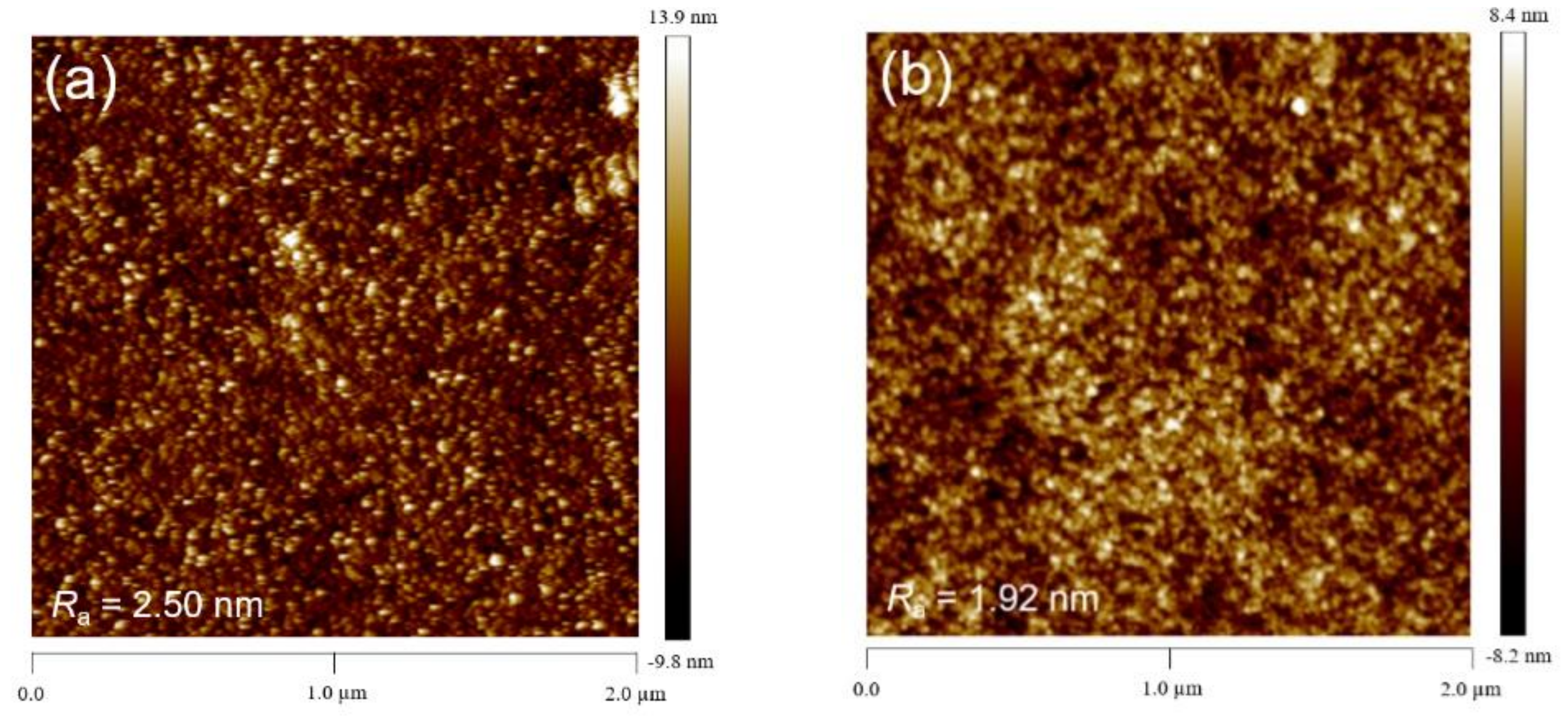
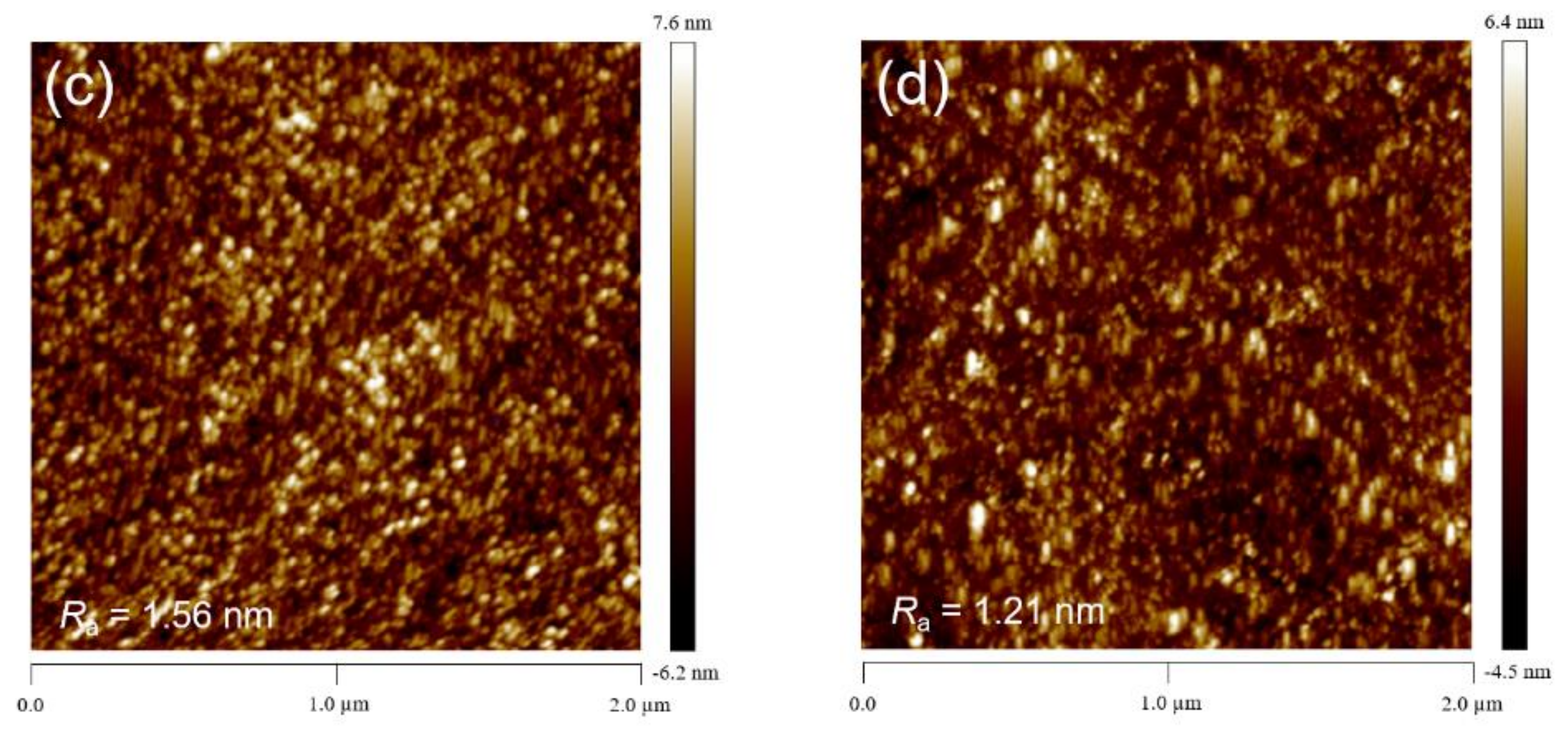
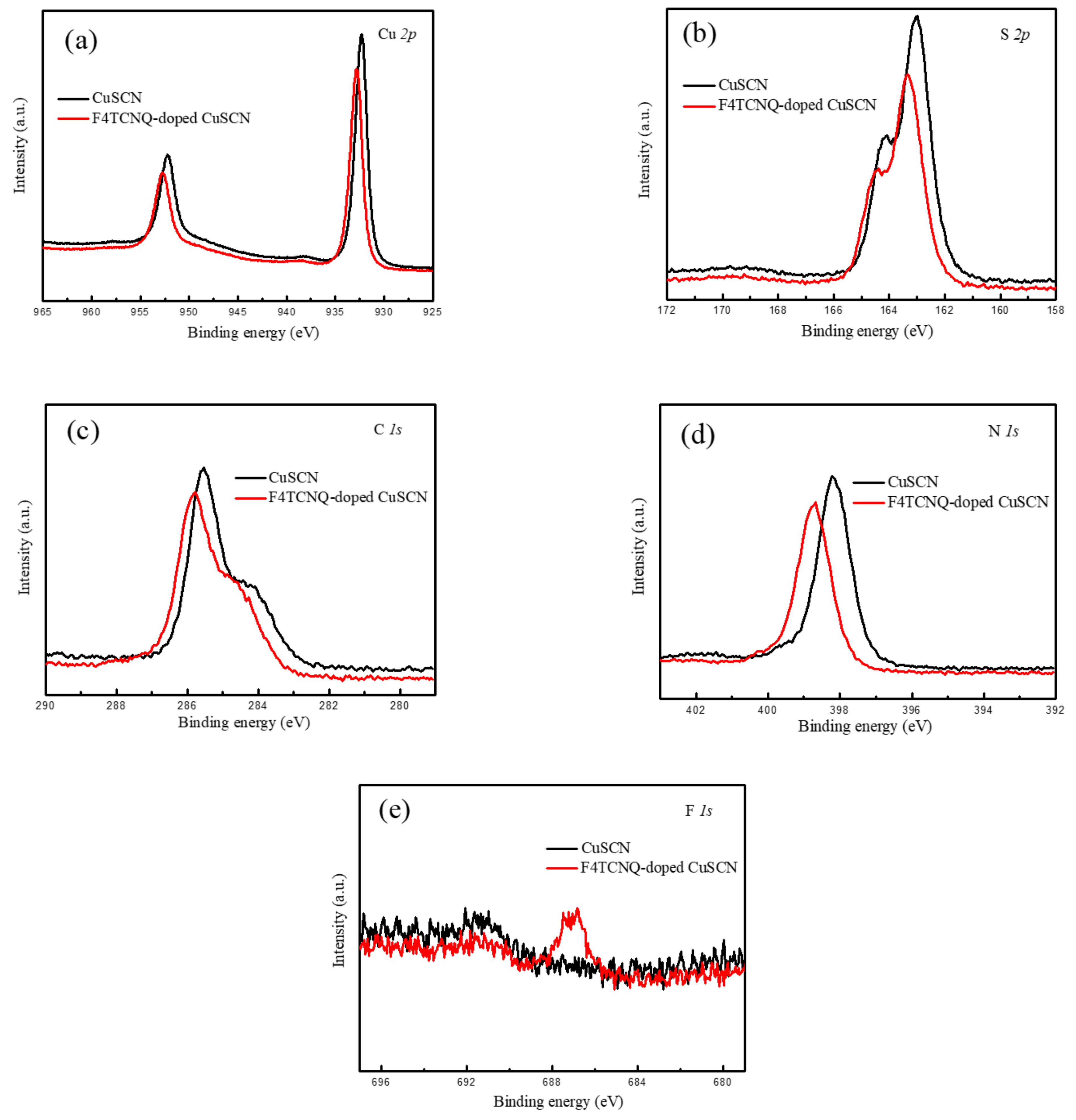
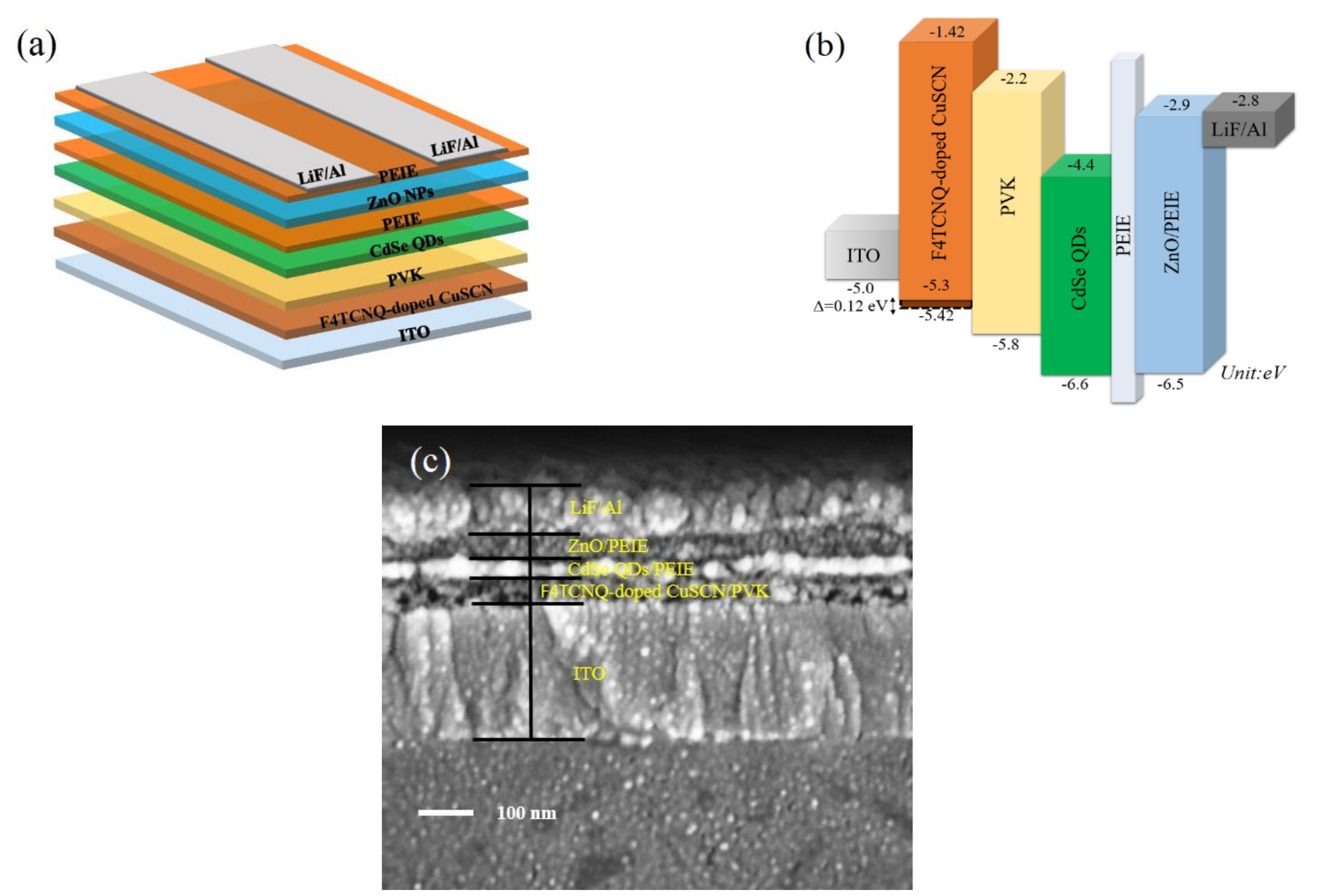

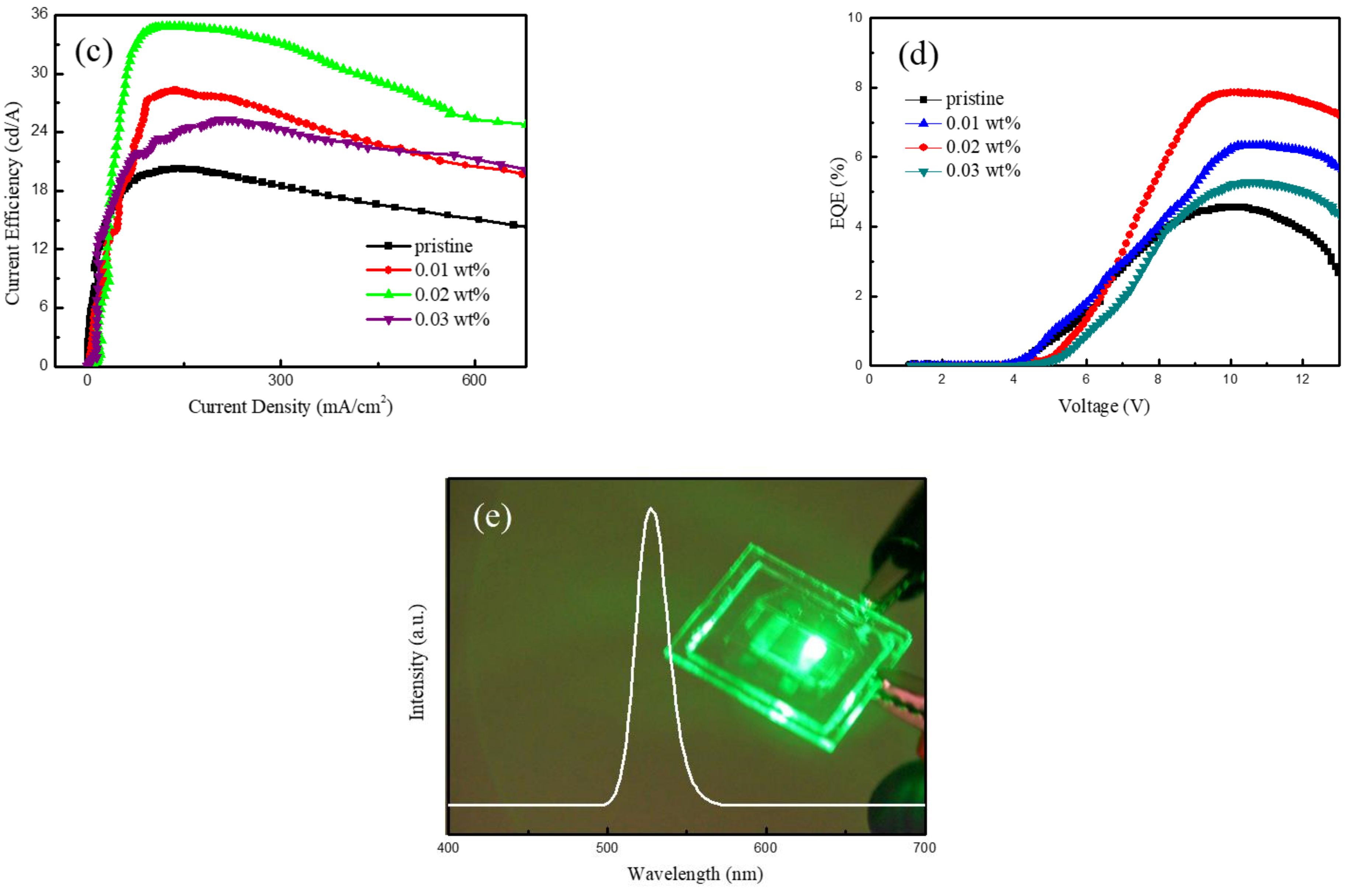

| Doping Ratio (wt%) | Von a (V) | Lmax (cd m−2 @V) | CEmax (cd A−1 @V) | EQEmax (% @V) |
|---|---|---|---|---|
| 0 | 4.03 | 125,129 @13.2 | 20.25 @10.0 | 4.57 @10.0 |
| 0.01 | 3.66 | 142,752 @14.8 | 28.29 @10.0 | 6.35 @10.0 |
| 0.02 | 3.60 | 169,230 @16.0 | 35.10 @9.90 | 7.91 @9.90 |
| 0.03 | 3.60 | 154,266 @13.8 | 25.49 @10.6 | 5.29 @10.6 |
| Device Structure | Vth (V) | Lmax (cd m−2) | CEmax (cd A−1) | Ref. |
|---|---|---|---|---|
| ITO/F4TCNQ-doped CuSCN/PVK/CdSe QDs/PEIE/ZnO NPs/PEIE/LiF/Al | 3.6 | 169,230 | 35.1 | This work |
| ITO/ZnO NPs/core–shell CdSe–ZnS QDs/PEIE/Poly-TPD/Cu:TPA/Al | 2.5 | 69,440 | 78.9 | [5] |
| ITO/ZnO NPs/CdSe@ZnS QDs/CBP/MoO3/Al | 2.4 | 218,800 | 19.2 | [6] |
| ITO/PEDOT:PSS/TFB/core–shell CdSe–ZnSe QDs/ZnO NPs/Al | N/A | 614,000 | N/A | [7] |
| ITO/ZnMgO/QDs/PVK/GO-doped PEDOT:PSS/Al | 4.1 | 142,165 | 30.4 | [9] |
| ITO/ZnO NPs/CdSe@ZnS-ZnS QDs/PEIE/Poly-TPD/MoOx/Al | 3.1 | 110,205 | 65.3 | [19] |
| ITO/CuSCN/PVK/CdSe QDs/TPBi/LiF/Al | 3.4 | 146,700 | 28.4 | [20] |
| ITO/PEDOT:PSS + BYK-P105/PVK/CdSe QDs/ZnO NPs/PEIE/LiF/Al | 3.8 | 139,909 | 27.2 | [25] |
| ITO/WO3 NPs/Poly-TPD/CdSe QDs/ZnO NPs/Al | 3.0 | 21,300 | 4.4 | [30] |
| ITO/PEDOT:PSS/Poly-TPD/CdZnSeS QDs/TPBi/LiF/Al | 3.5 | <10,000 | 5.2 | [46] |
| ITO/ZnO NPs/PEIE/core–shell CdSe–ZnS QDs/PVK/PEDOT:PSS/Al | 4.0 | 35,860 | 59.1 | [47] |
Publisher’s Note: MDPI stays neutral with regard to jurisdictional claims in published maps and institutional affiliations. |
© 2022 by the authors. Licensee MDPI, Basel, Switzerland. This article is an open access article distributed under the terms and conditions of the Creative Commons Attribution (CC BY) license (https://creativecommons.org/licenses/by/4.0/).
Share and Cite
Wen, M.-R.; Yang, S.-H.; Chen, W.-S. Solution-Processed Smooth Copper Thiocyanate Layer with Improved Hole Injection Ability for the Fabrication of Quantum Dot Light-Emitting Diodes. Nanomaterials 2022, 12, 154. https://doi.org/10.3390/nano12010154
Wen M-R, Yang S-H, Chen W-S. Solution-Processed Smooth Copper Thiocyanate Layer with Improved Hole Injection Ability for the Fabrication of Quantum Dot Light-Emitting Diodes. Nanomaterials. 2022; 12(1):154. https://doi.org/10.3390/nano12010154
Chicago/Turabian StyleWen, Ming-Ru, Sheng-Hsiung Yang, and Wei-Sheng Chen. 2022. "Solution-Processed Smooth Copper Thiocyanate Layer with Improved Hole Injection Ability for the Fabrication of Quantum Dot Light-Emitting Diodes" Nanomaterials 12, no. 1: 154. https://doi.org/10.3390/nano12010154
APA StyleWen, M.-R., Yang, S.-H., & Chen, W.-S. (2022). Solution-Processed Smooth Copper Thiocyanate Layer with Improved Hole Injection Ability for the Fabrication of Quantum Dot Light-Emitting Diodes. Nanomaterials, 12(1), 154. https://doi.org/10.3390/nano12010154







